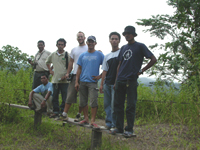The Sabah Biodiversity Experiment
Table of contents
Managing forest for carbon and tree diversity
Logged-over forest covers more than 85% of the remaining forested area in Sabah, Malaysian Borneo. Despite the overall importance it remains unclear how much carbon this type of forest stores. With respect to recent interests on REDD (Reducing Emissions from Deforestation and Degradation) there is a need to increase the knowledge on ecosystem service provision in Sabah which will be fundamental with regard to carbon and biodiversity credit trading in the near future. The projects were set up within a large scale forest rehabilitation project called the Sabah Biodiversity Experiment (SBE). It covers an area of 500 hectares of degraded forest in the Malua Forest Reserve, North of Danum Valley Conservation Area. The SBE aims to study the importance of tree species diversity, composition and life history traits for providing fundamental ecosystem services, such as carbon sequestration. The forest in this particular area was under logging activity during the early 1980s and has been recovering since. Our work shows how much carbon and tree diversity this particular forest stores and act as a baseline to measure future effects of rehabilitative treatments. We estimated a total carbon content of 237 Mg/ha, whereby above ground stocks (65%) and in particular trees >10 cm diameter breast height (57%) were the main contributors. An observational study on total soil respiration rates (including autotrophic and heterotrophic respiration) indicated a significantly lower rate in gap areas, compared to understorey sites. This effect was found to be similar under day- and night time conditions, but irrespective of abiotic (soil temperature, soil water content) and biotic conditions (litterfall, fine root biomass). We suggest that autotrophic respiration may be an important component of total soil respiration in degraded logged forest.
Shadehouse experiment
Dipterocarps act as a key species in undisturbed rainforests of South-East Asia, growing up to 70 meters high and providing shelter to this ecosystem. Their removal by logging alter may alter ecosystem dynamics such as associated levels of biodiversity, water storage and carbon sequestration. We established an artificial shadehouse experiment to force dipterocarp seedlings into altered carbon balance by either reducing or elevating light levels. These changes should simulate gap opening and closing processes in natural forest dynamics. Shade tolerators and light demanders were expected to respond differently to altered light conditions, therefore allowing to test the storage hypothesis of stress tolerance. Recent studies of carbon balance in tropical tree seedlings revealed the importance of nonstructural carbohydrates (NSC) for survival in shaded light conditions. In agreement with previous studies we found evidence that NSC (including starch and soluble sugars) responded to increased and decreased light levels dipterocarp seedlings. We used a Ca/Na-moderated ion partitioning column (HPLC) to separate the carbohydrates. In particular polyols contributed between 3-55% of total amounts of NSC depending on species and light exposure. Our results suggest that altered light environments in degraded forests may affect the carbon storage in regenerating dipterocarp seedlings.
Participants
Prof. Dr. Andy Hector (Project leader)
Dr. Philippe Saner
Dr. Glen Reynolds
Co-operation partners
NERC Centre for Population Biology, Imperial College, London, UK
UK Government’s Darwin Initiative
The Royal Society South East Asia Rainforest Research Programme (SEARRP)
University of Malaysia, Sabah
Sabah Forestry Department
Publications
- Philipson CD., Saner P., Marthews TR., Nilus R., Reynolds G., Turnbull LA., Hector A. (2012). Light-based regeneration niches: Evidence from 21 Dipterocarp species using size-specific RGRs. Biotropica, 44(5):627-636. DOI:10.1111/j.1744-7429.2011.00833.x
- Bagchi R., Philipson CD., Slade EM., Hector A., Phillips S., Villanueva JF., Lewis OT., Lyal CHC., Nilus R., Madran A., Scholes JD., Press MC. (2011) Impacts of logging on density-dependent predation of dipterocarp seeds in a South East Asian rainforest. Philosophical Transactions of the Royal Society B: Biological Sciences, 366(1582):3246-3255. DOI:10.1098/rstb.2011.0034
- Hector A., Philipson C., Saner P., Chamagne J., Dzulkifli D., O'Brien M., Snaddon JL., Ulok P., Weilenmann M., Reynolds G., Godfray HCJ. (2011). The Sabah biodiversity experiment: a long-term test of the role of tree diversity in restoring tropical forest structure and functioning. Philosophical Transactions of the Royal Society B: Biological Sciences, 366(1582):3303-3315. DOI: 10.1098/rstb.2011.0094
- Saner P., Philipson C., Ong RC., Majalap N., Egli S., Hector A. (2011). Positive effects of ectomycorrhizal colonization on growth of seedlings of a tropical tree across a range of forest floor light conditions. Plant and Soil, 338(1-2):411-421. DOI: 10.1007/s11104-010-0555-3
- Hautier Y., Saner P., Philipson C., Bagchi R., Ong RC., Hector A. (2010). Effects of seed predators of different body size on seed mortality in Bornean logged forest. PLoS ONE, 5(7):e11651. DOI: 10.1371/journal.pone.0011651
- Saner P., Lim R., Burla B., Scherer-Lorenzen M., Hector A. (2009). Reduced soil respiration in gaps in logged lowland dipterocarp forests. Forest Ecology and Management, 258:2007-2012. DOI: 10.1016/j.foreco.2009.07.048
- Saner PG. (2009). Ecosystem carbon dynamics in logged forest of Malaysian Borneo. Ph.D. thesis, University of Zurich

